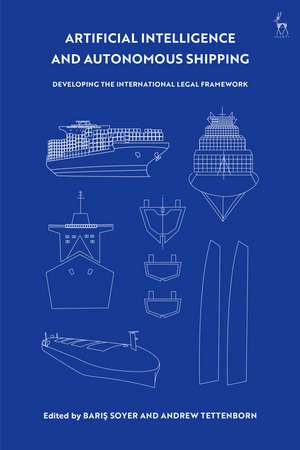Artificial Intelligence and Autonomous Shipping: Developing the International Legal Framework
Editat de Baris Soyer, Andrew Tettenbornen Limba Engleză Paperback – 16 noi 2022
| Toate formatele și edițiile | Preț | Express |
|---|---|---|
| Paperback (1) | 311.17 lei 6-8 săpt. | |
| Bloomsbury Publishing – 16 noi 2022 | 311.17 lei 6-8 săpt. | |
| Hardback (1) | 568.87 lei 6-8 săpt. | |
| Bloomsbury Publishing – 19 mai 2021 | 568.87 lei 6-8 săpt. |
Preț: 311.17 lei
Preț vechi: 381.73 lei
-18% Nou
Puncte Express: 467
Preț estimativ în valută:
59.56€ • 64.72$ • 50.06£
59.56€ • 64.72$ • 50.06£
Carte tipărită la comandă
Livrare economică 21 aprilie-05 mai
Preluare comenzi: 021 569.72.76
Specificații
ISBN-13: 9781509947935
ISBN-10: 1509947930
Pagini: 256
Dimensiuni: 156 x 234 x 17 mm
Greutate: 0.33 kg
Editura: Bloomsbury Publishing
Colecția Hart Publishing
Locul publicării:London, United Kingdom
ISBN-10: 1509947930
Pagini: 256
Dimensiuni: 156 x 234 x 17 mm
Greutate: 0.33 kg
Editura: Bloomsbury Publishing
Colecția Hart Publishing
Locul publicării:London, United Kingdom
Caracteristici
Critically evaluates the legal framework necessary for the use of autonomous ships in international waters
Notă biografică
Baris Soyer is Professor of Commercial and Maritime Law and Director and Andrew Tettenborn is Professor of Commercial Law, both at the Institute of International Shipping and Trade Law at Swansea University.
Cuprins
PART I MASS IN THE CONTEXT OF THE EXISTING LEGAL FRAMEWORK1. International Regulation of Shipping and Unmanned Vessels Professors Simon Baughen, Swansea University, UK and Andrew Tettenborn, Swansea University, UKI. Introduction A. Degrees of Automation B. The Approach of the CMI and this Chapter C. The Master and the Crew - A Definitional Issue II. The Issues Arising A. Manning Requirements B. References to Onboard Human Activity by Master or Crew C. Documentary Requirements D. Vessel Construction, Design and Operation: SOLAS, ISPS and Beyond III. Conclusion 2. International Law of the Sea and Autonomous Cargo 'Vessels' Dr Youri van Logchem, Swansea University, UK I. Introduction II. Maritime Autonomous Craft and the Law of the Sea: An Overview III. The Threshold Question of Defining Autonomous Cargo Craft as Ships/Vessels A. Reviewing the State of the Art B. What Constitutes a Ship/Vessel under International Law of the Sea? C. What Constitutes a Ship/Vessel Under the LOSC? D. Applying the General Rule on Treaty Interpretation to the Terms Ship/Vessel as Contained in the LOSC IV. The Entitlement of Vessels to Navigational Rights and Freedoms A. Internal Waters B. Territorial Sea C. Straits D. EEZ/High Seas V. Flag State Jurisdiction A. The Genuine Link Requirement B. The Impact of a Master, Officers and Crew Not Being on Board a Ship on a Flag State's Ability to Performits Obligations C. Rendering Assistance at Sea VI. Charting the Way Forward A. International Adjudication of Disputes Concerning Autonomous Maritime Craft B. Reading the Language of the LOSC Teleologically C. Amending the Existing Regime, Creating a New One or Involving the IMO - Scouring the Field for aRealistic Option VII. Concluding Remarks 3. Autonomous Ships and Private Law Issues Professors Baris Soyer, Swansea University, UK and Andrew Tettenborn, Swansea University, UK I. Changes to Existing Regimes A. Liability for Negligent Navigation (Collisions) B. Salvage C. Arrest D. Limitation of Liability E. Wreck Removal II. Reach of Particular Regimes: Definition of the Vessels to Which they Apply A. Negligent Navigation (Collisions) B. Salvage C. Pollution D. Wreck Removal E. Limitation of Liability F. Arrest G. Strict Liability under the Harbours, Docks and Piers Clauses Act 1847 III. Concluding Thoughts 4. Unmanned Vessels and International Conventions for the Carriage of Goods by Sea Professor Simon Baughen, Swansea University, UKI. International Liability Conventionsfor the Carriage of Goods by Sea A. The Hague and Hague-Visby Rules B. The Hamburg Rules 1978 C. The Rotterdam Rules 2008 D. Title to Sue: The Carriage of Goods by Sea Act 1992 E. General Average II. Charterparties A. Demise Charters: Barecon 2001 B. Time Charters: NYPE 2015 C. Voyage Charters: GENCON 1994 III. Conclusion PART IIMASS: NEW LEGAL ISSUES EMERGING AND INSURANCE5. Cyber Risks, Autonomous Operations and Risk Perceptions: Is a New Liability Paradigm Required? Associate Professor George Leloudas, Swansea University, UKI. Changing Physical World II. The Relevance of Cyber Risks Management for Shipping Operations III. The Impact of Cyber Risks on International Conventions A. Passenger Liability under the 2002 Athens Convention B. Cyberworthiness and Contracts of Carriage of Goods IV. Autonomous Operations and Cyber Risks V. Time to Consider the Liability Paradigm? VI. Conclusion 6. Product Liability: Autonomous Ships Associate Professor Roderick Bagshaw, Oxford University, UKI. Personal Injuries A. Product B. Producer C. Defendants Other than the Producer D. Defect E. Development Risk II. Physical Damage to External Commercial Property, Such as a Different Vessel A. Duty of Care B. Fault III. Physical Damage to the Autonomous Vessel Itself IV. Losses as a Result of an Inability to Use the Autonomous Vessel for a Period for Reasons Other than the Need to Perform Physical Repairs V. Conclusions 7. Maritime Autonomous Surface Ships: Marine Insurance Response to Risks Peter MacDonald Eggers QC, 7 King's Bench Walk, UKI. Introduction II. Developments in the Maritime Industry III. Issues Concerning Good Faith A. The Assured's Duty of Fair Presentation of the RiskB. The Effect of the Insurer's Knowledge on the Assured's Risk Presentation IV. The Cover Afforded by Traditional Marine Policies: Non-affirmative Cover and Exclusions V. Affirmative Cover or Exclusions VI. The Potential Statutory Liability of Insurers VII. Claims Presentation and Handling VIII. Conclusion PART IIITHE WAY FORWARD8. The Future of Autonomous Shipping - The Regulatory Challenge Professor Baris Soyer, Swansea University, UK I. Introduction II. Problems and Challenges Facing the Regulatory Process A. Technical Barriers B. The Nature of Technological Developments C. Additional Complications D. Different Pressures and Challenges in Regulating Different Areas of Maritime Law - Different Courses for Different Horses III. The Shape of International Regulation - The Way Forward A. Technical Rules on Safety, Pollution Prevention andTraining/Watchkeeping Standards B. Private Maritime Law Rules IV. Concluding Remarks
